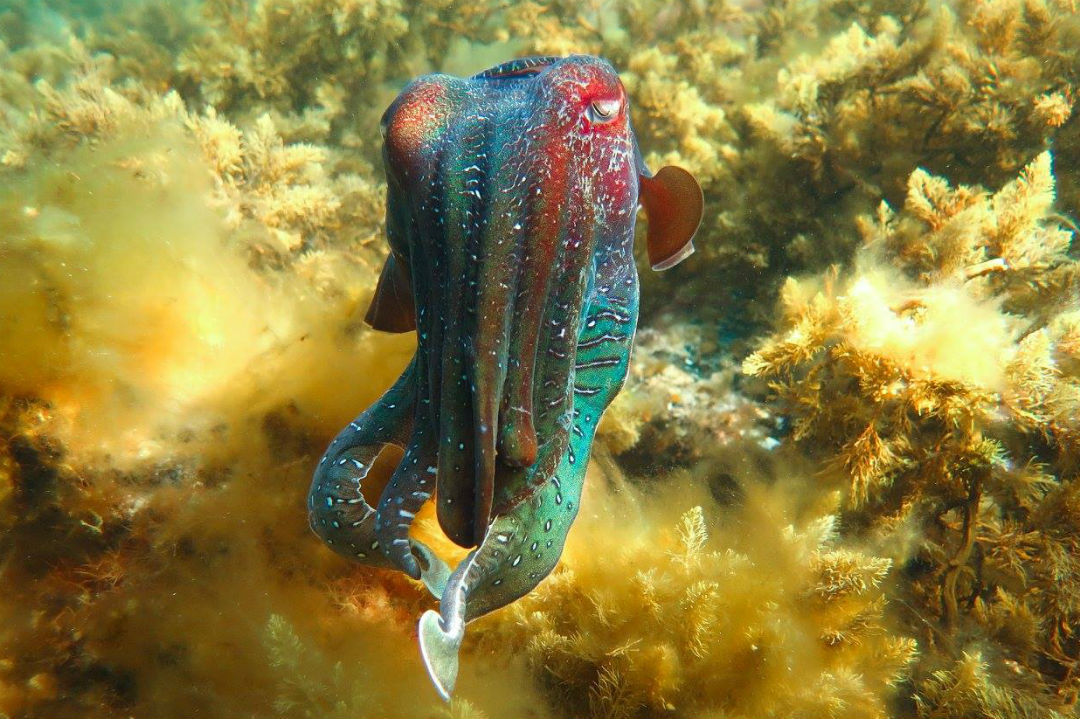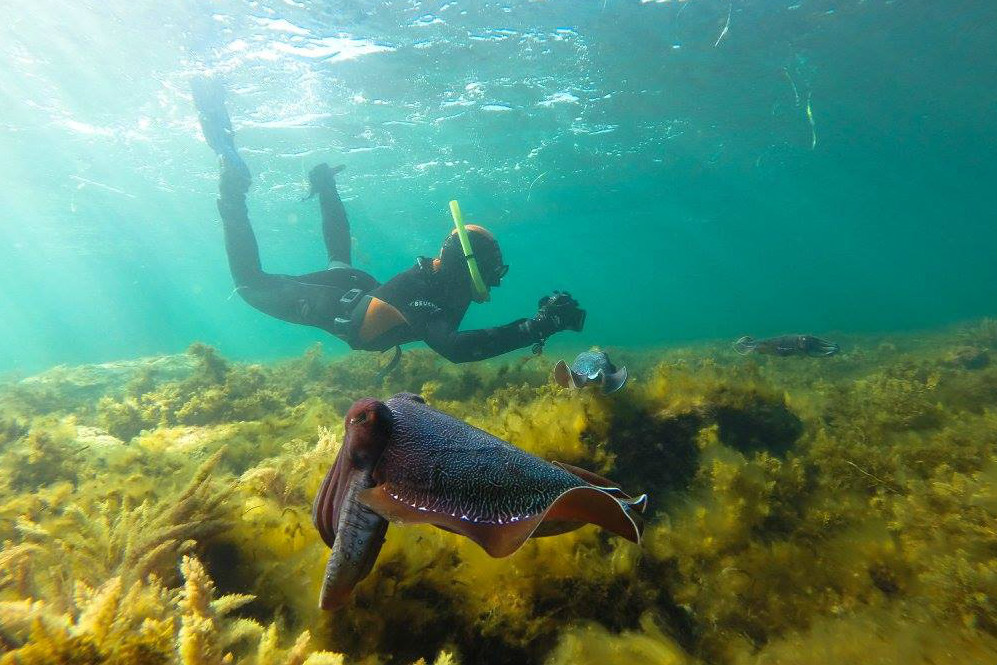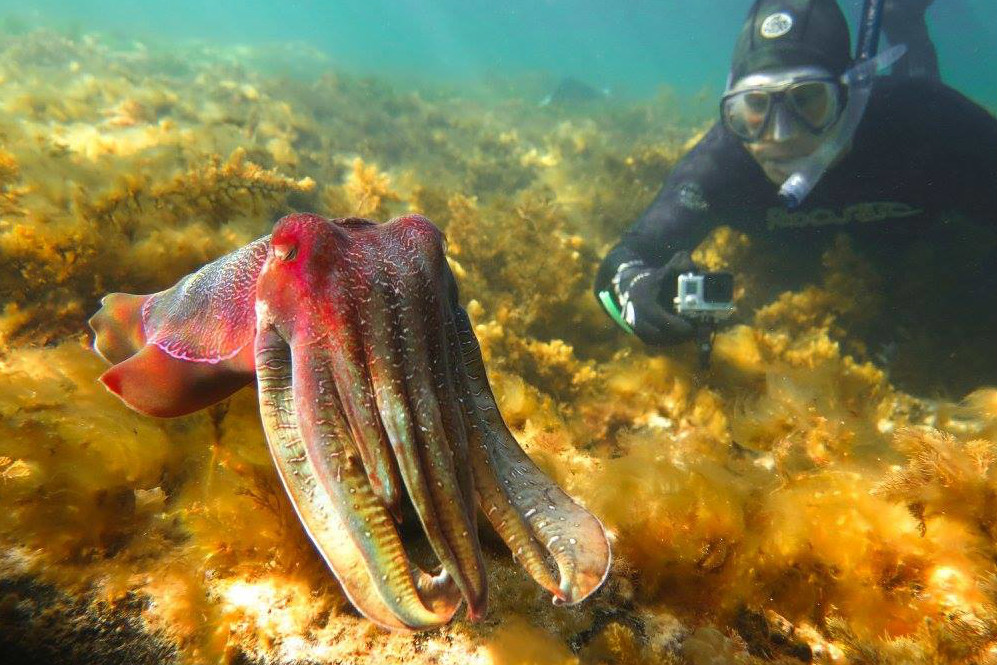
Everything you need to know about giant Australian cuttlefish in South Australia
Every winter thousands of giant Australian cuttlefish congregate in SA. Learn where, why and how to swim with them.
The giant Australian cuttlefish is exactly what its name suggests – the largest of all the cuttlefish species. Males can be particularly big in size and measure up to 50 cm long and weigh about 10 kg.
These intelligent creatures are expert colour-changers and masters of camouflage, and can change shape and texture to look like rocks, sand or seaweed – a spectacular sight to see.

Giant cuttlefish can be found anywhere between the southern coastal waters of Australia to the east-coast of Queensland, and on the west-coast up to Ningaloo Reef in Western Australia.
Giant Australian cuttlefish congregate off the coast of Whyalla in South Australia, along a 10 km stretch of the Upper Spencer Gulf Marine Park. Cuttlefish numbers usually increase throughout May and peak in June and July when the breeding season is in full swing.
So if you’re heading to Whyalla or Spencer Gulf, pack your wetsuit and snorkel gear and get a glimpse of these majestic creatures.
Why do giant Australian cuttlefish migrate to South Australia?
SA’s waters are the only place in the world where the cuttlefish congregate annually en mass and with such great predictability. Their sole purpose? Spawning! Their underwater light shows, cunning games and dramatic colour displays are all to lure a mate for breeding.
The waters around Point Lowly and Stony Point in the Upper Spencer Gulf Marine Park have rocky seabeds, which provide the perfect environment for females to lay and delicately attach their eggs.
The sheer number of cuttlefish makes the Whyalla breeding season aggregations unique, not just in Australia, but in the world.
Why the colourful show?
As part of the breeding process, male cuttlefish make it a point to look absolutely stunning. They put on a spectacular display of colours and shape-shifting to attract and keep a mate. Kind of like a dance-off!
How can you swim or dive with cuttlefish?
You can swim, snorkel or dive with giant Australian cuttlefish up-close in waters around Point Lowly and Stony Point, also known as Cuttlefish Coast.

You can go at it alone or book a guided snorkel tour.
The best spot for young families to experience the giant Australian cuttlefish congregation is at Stony Point, about 20 km northeast of Whyalla. There’s easy access via a boardwalk to the shallow water and a waist-height chain to hold onto for support, making it the safest point to enter or exit.
Read all about what it’s like to swim with giant Australian cuttlefish here.
Top tip: You can sometimes find cuttlefish in less than a metre of water.
What should you wear?
In the winter months, the water is cold so a well-fitting full length 5 mm or 7mm thick wetsuit with hood, gloves and boots is the way to go. If you haven’t got your own gear you can always hire it from Whyalla Diving Services.
Do the cuttlefish care that you’re there?
The sheer size and quick colour-changing behaviour of the cuttlefish can be intimidating at first, but after a few minutes you realise they only have one thing on their mind – finding a mate!
If you’re careful to move slowly, you can get up close without disturbing the cuttlefish. They seem oblivious to people and are focused on breeding.
But remember to respect their space – look but don’t touch.

Are cuttlefish safe to swim near?
Snorkelling is safe along Point Lowly and Stony Point, but you do need to be careful when entering water over rocks and boulders, as they can be unstable and slippery.
Top tip: Prefer to see these majestic wonders without getting a foot wet? There’s also a glass-bottomed boat experience you can try.
If you’d rather learn about the underwater creatures hanging out in SA’s waters from the comfort of dry land, check out our blogs about sea dragons, blue devil fish and squid.
(Main image courtesy of Jamie Hicks)
This story was originally posted in May 2022 and has been updated with new information.